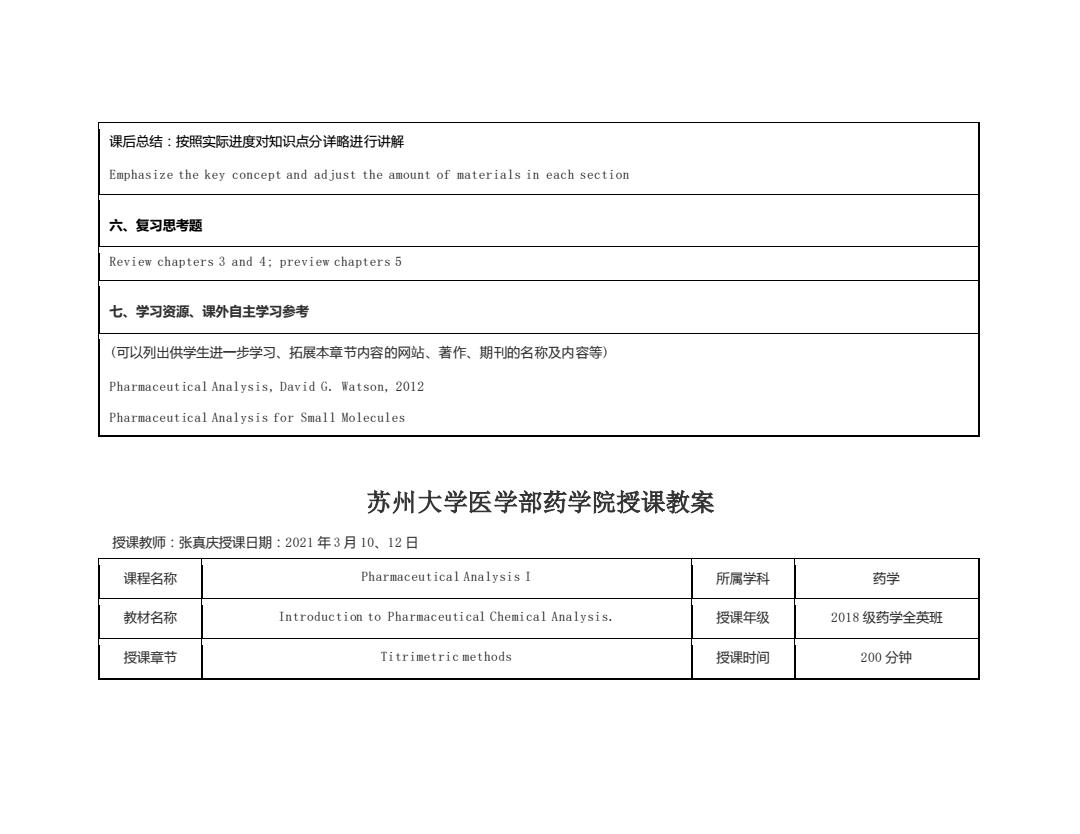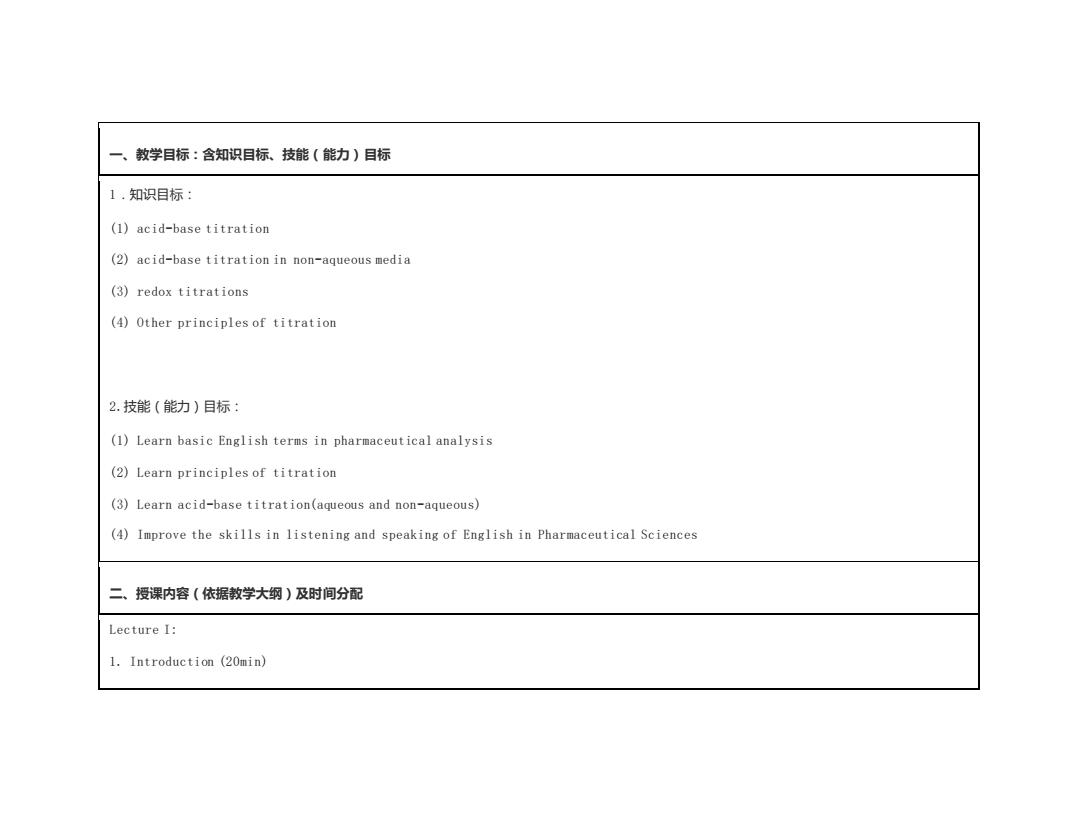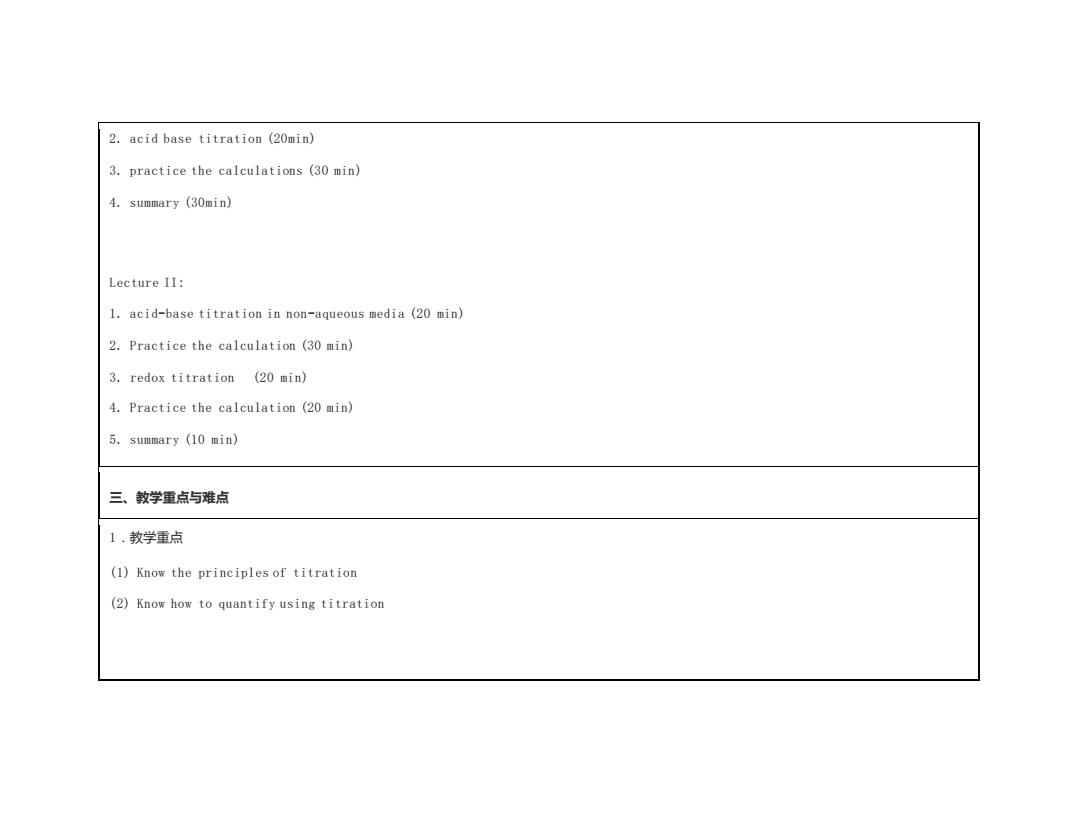
1.理论课堂教学 A.多媒体教学:(简要列出本章节多媒体教学设计特点及优势) (1)Use case study to explain the fundamentals of chemical properties (2)Use case study to explain the fundamentals of pharmaceutical analysis (3)Review the major concepts and materials covering the chapter. (4)Work on problems with students together to emphasize the basic principles covered in the chapter B.互动教学:(根据实际情况列出案例/实例时论、分析讨论、分组讨论、翻转课堂等互动教学内容标题) (1)Ask questions during case studies before and after introducing basic concepts (2)Discuss the complicated concepts (3)Solve problems together with students 2.实验课教学 No applicable. 五、更新或补充内容提要
1.理论课堂教学 A.多媒体教学:(简要列出本章节多媒体教学设计特点及优势) (1) Use case study to explain the fundamentals of chemical properties (2) Use case study to explain the fundamentals of pharmaceutical analysis (3) Review the major concepts and materials covering the chapter. (4) Work on problems with students together to emphasize the basic principles covered in the chapter B.互动教学:(根据实际情况列出案例/实例讨论、分析讨论、分组讨论、翻转课堂等互动教学内容标题) (1) Ask questions during case studies before and after introducing basic concepts (2) Discuss the complicated concepts (3) Solve problems together with students 2.实验课教学 No applicable. 五、更新或补充内容提要

课后总结:按照实际进度对知识点分详略进行讲解 Emphasize the key concept and ad just the amount of materials in each section 六、复习思考题 Review chapters 3 and 4:preview chapters 5 七、学习资源、课外自主学习参考 (可以列出供学生进一步学习、拓展本章节内容的网站、著作、期刊的名称及内容等) Pharmaceutical Analysis,David G.Watson,2012 Pharmaceutical Analysis for Small Molecules 苏州大学医学部药学院授课教案 授课教师:张真庆授课日期:2021年3月10、12日 课程名称 Pharmaceutical Analysis I 所属学科 药学 教材名称 Introduction to Pharmaceutical Chemical Analysis. 授课年级 2018级药学全英班 授课章节 Titrimetric methods 授课时间 200分钟
课后总结:按照实际进度对知识点分详略进行讲解 Emphasize the key concept and adjust the amount of materials in each section 六、复习思考题 Review chapters 3 and 4; preview chapters 5 七、学习资源、课外自主学习参考 (可以列出供学生进一步学习、拓展本章节内容的网站、著作、期刊的名称及内容等) Pharmaceutical Analysis, David G. Watson, 2012 Pharmaceutical Analysis for Small Molecules 苏州大学医学部药学院授课教案 授课教师:张真庆授课日期:2021 年 3 月 10、12 日 课程名称 Pharmaceutical Analysis I 所属学科 药学 教材名称 Introduction to Pharmaceutical Chemical Analysis. 授课年级 2018 级药学全英班 授课章节 Titrimetric methods 授课时间 200 分钟

一、教学目标:含知识目标、技能(能力)目标 1.知识目标: (1)acid-base titration (2)acid-base titration in non-aqueous media (3)redox titrations (4)Other principles of titration 2.技能(能力)目标: (1)Learn basic English terms in pharmaceutical analysis (2)Learn principles of titration (3)Learn acid-base titration(aqueous and non-aqueous) (4)Improve the skills in listening and speaking of English in Pharmaceutical Sciences 二、授课内容(依据教学大纲)及时间分配 Lecture I: 1.Introduction (20min)
一、教学目标:含知识目标、技能(能力)目标 1.知识目标: (1) acid-base titration (2) acid-base titration in non-aqueous media (3) redox titrations (4) Other principles of titration 2.技能(能力)目标: (1) Learn basic English terms in pharmaceutical analysis (2) Learn principles of titration (3) Learn acid-base titration(aqueous and non-aqueous) (4) Improve the skills in listening and speaking of English in Pharmaceutical Sciences 二、授课内容(依据教学大纲)及时间分配 Lecture I: 1. Introduction (20min)

2.acid base titration (20min) 3.practice the calculations (30 min) 4.summary (30min) Lecture II: 1.acid-base titration in non-aqueous media(20 min) 2.Practice the calculation (30 min) 3.redox titration (20 min) 4.Practice the calculation (20 min) 5.summary (10 min) 三、教学重点与难点 1.教学重点 (1)Know the principles of titration (2)Know how to quantify using titration
2. acid base titration (20min) 3. practice the calculations (30 min) 4. summary (30min) Lecture II: 1. acid-base titration in non-aqueous media (20 min) 2. Practice the calculation (30 min) 3. redox titration (20 min) 4. Practice the calculation (20 min) 5. summary (10 min) 三、教学重点与难点 1.教学重点 (1) Know the principles of titration (2) Know how to quantify using titration

2.教学难点 (1)understand the principles of titration (2)understand how to quantify using titration 四、教学方法选择
2.教学难点 (1) understand the principles of titration (2) understand how to quantify using titration 四、教学方法选择